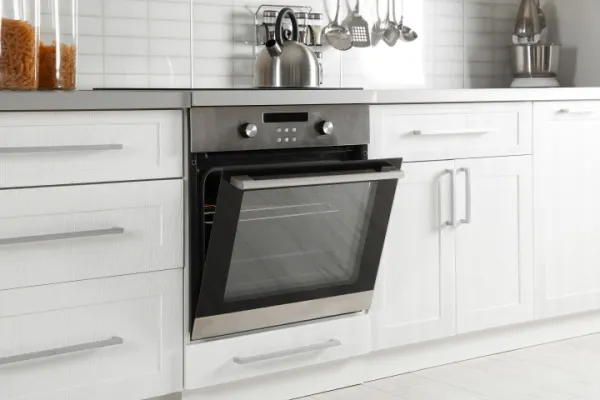
Molly Maid explains that using your oven’s self-cleaning mode is generally safe if you follow these key precautions.
|
There’s a lot of confusion over the “self-cleaning” oven feature. Is it safe and effective? Is it expensive to use? Is it perfectly great, and if not, is there a better alternative?
General Electric introduced the first oven with a self-cleaning feature in 1963. With excitement and curiosity, consumers raised their eyebrow and opened their wallets. After all, cleaning an oven by hand was grueling. In addition, the leading oven-cleaning products pose health risks, and this raises the question — does the residue left by these products then bake into our chicken and casseroles? [Shudder.]
So, it makes sense that oven owners for decades have wanted to embrace the self-cleaning mode. Yet, many who have the feature choose not to use it. Why is that? It’s because there are a few “catches” that have received attention and that have warranted some degree of alarm from appliance and public health experts.
Is My Self-Cleaning Oven Safe?
As long as your oven is in good working order, using the self-cleaning oven feature is safe. They wouldn’t have created this feature if it wasn’t! That said, it can create some inconveniences and is best done when your home can be well ventilated.
Self-Cleaning Oven Problems:
- Not all ovens are the same. First off, the feature, which heats up your oven to 900 or 1,000 degrees to incinerate food particles and takes 3-6 hours to complete, ranges in effectiveness from model to model and price range to price range.
- Dangerous fumes. Secondly, it also has its own health worries: Fumes, including carbon monoxide from incinerating food particles, can emanate from a self-cleaning oven. Some manufacturers recommend removing pet birds from the home first because they are especially sensitive to fumes, a la the “canary in a coal mine.”
- Self-cleaning oven smoke. Thirdly, by using the self-cleaning feature, you’re trading convenience for inconvenience: The self-cleaning mode can produce smoke that sets off your fire alarms and chokes your home. Be sure to open windows and use the range hood – which means loud white noise for hours at a time and perhaps humid or cold air coming into your home that you might not want.
- Broken ovens. Fourthly, appliance technicians have reported that non-responsive electronic control panels and burned-out calrods — tubular elements that convert electricity into heat — are common repair calls for ovens that have broken during the extreme heat of self-cleaning.
- Extreme energy usage. A final downside is the energy it takes to heat up an oven to 900 or 1,000 degrees for hours at a time. A test found that using the self-cleaning feature consumed 8 kilowatt-hours of electricity, or about as much energy as they usually drew from their oven in a month of normal usage. The good news is that special insulation that self-cleaning ovens come with makes them more energy-efficient than regular ovens, but if you use the self-cleaning feature more than once per month, you will use more energy than you would otherwise with an oven that’s not self-cleaning.
To Self-Clean, or Not to Self-Clean
If you read your manual carefully and tried your oven’s self-cleaning mode with great success and your pets and children were not bothered by fumes or smoke, then maybe you’re all set! We also live in a world where you can search the web for reviews written by other owners of the same oven as yours about their experience with the self-cleaning feature.
Self-Cleaning Alternatives
What if you prefer not to deal with the self-cleaning feature? You are not alone. Your two remaining options are to 1) clean your oven with conventional toxic cleaners and also 2) to explore lesser-toxic homemade solutions and see if you can get your oven clean with those.
The single-best nontoxic option people report having success with is making a paste of baking soda and vinegar and applying it to the spills in your oven, letting the paste sit for an hour or even better, overnight, and then wiping the spills and splats away with a little elbow grease.
If that doesn’t work to your satisfaction, consider liquid ammonia. It’s less toxic than leading brands of oven cleaner because it’s a liquid, not an aerosol, yet it’s still hazardous.
Here’s how to use it (this trick is not safe for gas ovens):
- Let ammonia sit. Heat your electric oven to 150 degrees, turn oven off, then place a small bowl of ammonia (half-cup) on your top shelf and a pan of boiling-hot water on the lower shelf. Close oven door and let it sit there overnight.
- Air out oven. The next day, remove the bowl and pan and allow it to air out – use kitchen vent and open windows – so you and your loved ones are not exposed to ammonia fumes.
- Scrub oven. Then, add a few drops of dish soap to some ammonia, put on some gloves and use a rough sponge or cloth to clean the oven. If you have any problem areas, allow the cloth to sit for a half-hour, then wipe away. A soft bristle brush might also come in handy.
- Wipe down oven. When the oven is clean, wipe down oven interior with water to remove ammonia and detergent.
Be careful. Ammonia fumes can cause burning of the eyes, nose, throat and respiratory tract, and even blindness in extreme cases. And an additional important warning: Do not combine ammonia with any bleach-based cleaners, which will produce a deadly gas.
Dispose of ammonia by running down the drain with plenty of water.
Let Molly Maid Help
Whether you use commercial cleaning products or homemade pastes and solutions, oven cleaning is never the most pleasant, and it’s always a bit time-consuming. For decades, Molly Maid has been making homeowners’ lives easier by making their homes — and kitchens — a lot cleaner. We can do the same for you. Contact your local Molly Maid, a Neighborly® company or call to ask about home cleaning services that meet your schedule, budget and cleaning needs — including that oven-cleaning task!
